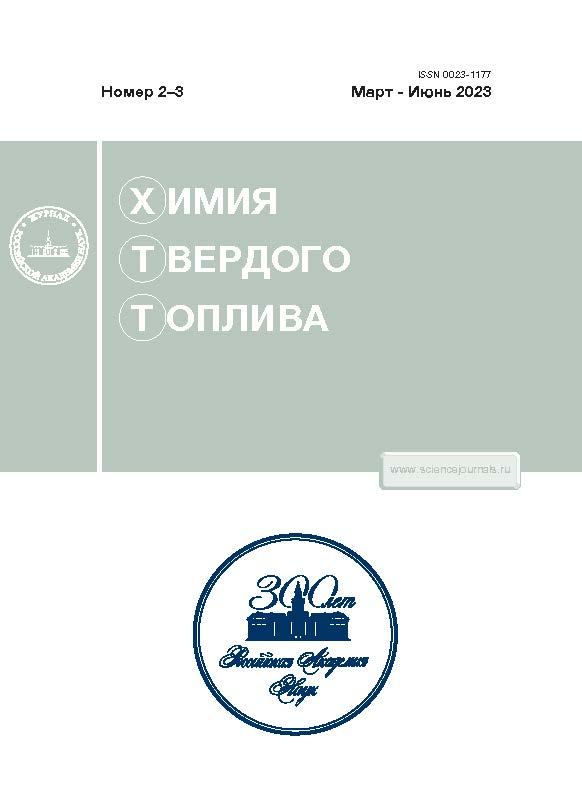Influence of Heat Treatment Conditions on the Composition of Cracking Products of Oil Shale from the Kashpir Deposit
- 作者: Mozhayskaya M.V.1, Pevneva G.S.1, Krivtsov E.B.1, Pantilov P.V.1
-
隶属关系:
- Institute of Petroleum Chemistry, Siberian Branch, Russian Academy of Sciences
- 期: 编号 2-3 (2023)
- 页面: 20-25
- 栏目: Articles
- URL: https://rjmseer.com/0023-1177/article/view/661869
- DOI: https://doi.org/10.31857/S002311772302010X
- EDN: https://elibrary.ru/BPOCEV
- ID: 661869
如何引用文章
详细
The cracking of oil shale from the Kashpir deposit was studied at various temperatures (425, 450, and 475°C) and process durations (40, 60, 80, and 100 min.). It was shown that the highest yields of liquid products and oils in their composition were achieved at a cracking temperature of 450°C and a duration of 100 min. An increase in the temperature and duration of cracking led to an increase in the concentration of С1–С5 hydrocarbons in the gaseous products by a factor of 2–5. Oils isolated from the liquid products of oil shale cracking consisted of 30–45% polycyclic aromatic hydrocarbons. It was established that an increase in the temperature and duration of cracking led to an increase in the concentration of IBP–360°C fractions in the composition of liquid products.
作者简介
M. Mozhayskaya
Institute of Petroleum Chemistry, Siberian Branch, Russian Academy of Sciences
Email: mozhayskaya@ipc.tsc.ru
Tomsk, 634055 Russia
G. Pevneva
Institute of Petroleum Chemistry, Siberian Branch, Russian Academy of Sciences
Email: pevneva@ipc.tsc.ru
Tomsk, 634055 Russia
E. Krivtsov
Institute of Petroleum Chemistry, Siberian Branch, Russian Academy of Sciences
Email: john@ipc.tsc.ru
Tomsk, 634055 Russia
P. Pantilov
Institute of Petroleum Chemistry, Siberian Branch, Russian Academy of Sciences
编辑信件的主要联系方式.
Email: 6tinygamer10@gmail.com
Tomsk, 634055 Russia
参考
- Kang Z., Zhao Y., Yang D. // Appl. Energy. 2020. T. 269. P. 115121.
- Lu Y., Wang Y., Zhang J., Wang Q., Zhao Y., Zhang Y. // Energy. 2020. V. 200. P. 117529.
- Симонов В.Ф., Каширский В.Г., Левушкина Л.В. // Вестн. Саратовск. ун-та. 2008. № 1. С. 77–81.
- Рыжов А.Н., Авакян Т.А., Сахарова Е.А., Маслова Л.К., Смоленский Е.А., Лапидус А.Л. // ХТТ. 2013. № 4. С. 29. [Solid Fuel Chemistry. 2013. vol. 47, no. 2, p. 88–97. https://doi.org/10.3103/S0361521913020092]https://doi.org/10.7868/S0023117713020096
- Zendehboudi S., Bahadori A. // Gulf Professional Publishing. 2016. 426 p.
- Shawabkeh A.Q., Abdulaziz M. // Oil Shale. 2013. V. 30. № 2. P. 173.
- Гюльмалиев А.М., Каирбеков Ж.К., Малолетнев А.С., Емельянова В.С., Малтыкбаева Ж.К. // ХТТ. 2013. № 6. С. 49. [Solid Fuel Chemistry. 2013. vol. 47, no. 6, p. 360–364. https://doi.org/10.3103/S0361521913060037]https://doi.org/10.7868/S0023117713060030
- Yarboboev T., Sultanov Sh., Aminov F., Navotova D. // Bull. Sci. Pract. 2020. V. 6. No. 7. P. 226.
- Можайская М.В., Сурков В.Г., Копытов М.А., Головко А.К. // Журн. Сиб. фед. ун-та. Химия. 2019. Т. 12. № 3. С. 319.
- Певнева Г.С., Воронецкая Н.Г., Гринько А.А., Головко А.К. // Нефтехимия. 2016. Т. 56. № 5. С. 461. [Petroleum Chemistry, 2016, vol. 56, no. 8, p. 690–696. https://doi.org/10.1134/S0965544116080144]https://doi.org/10.7868/S0028242116050154










